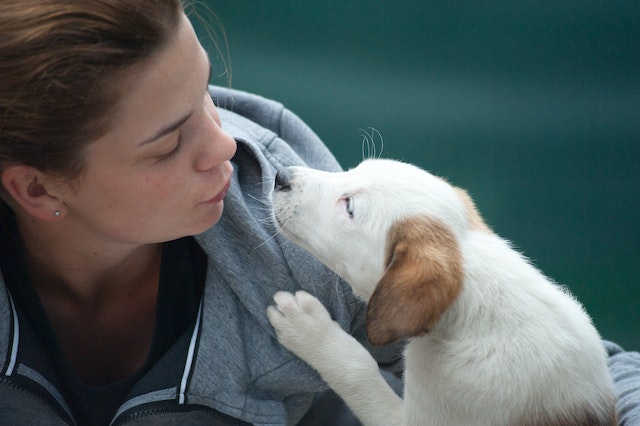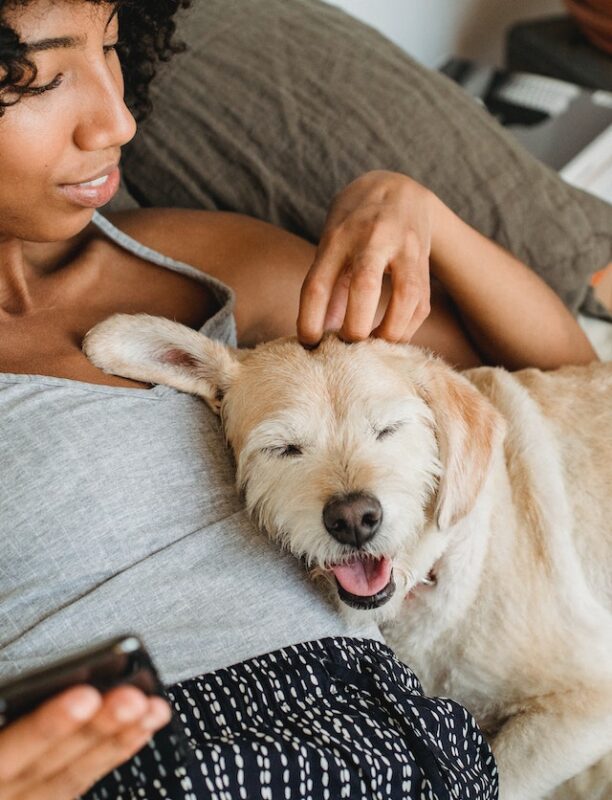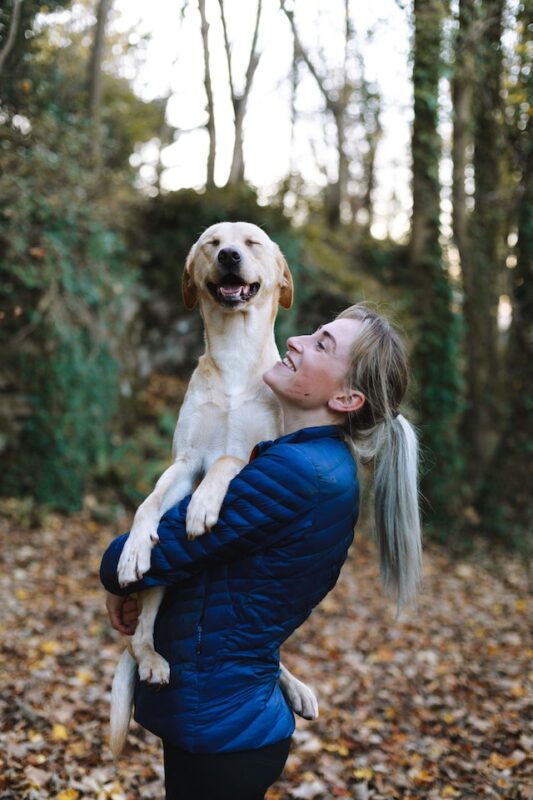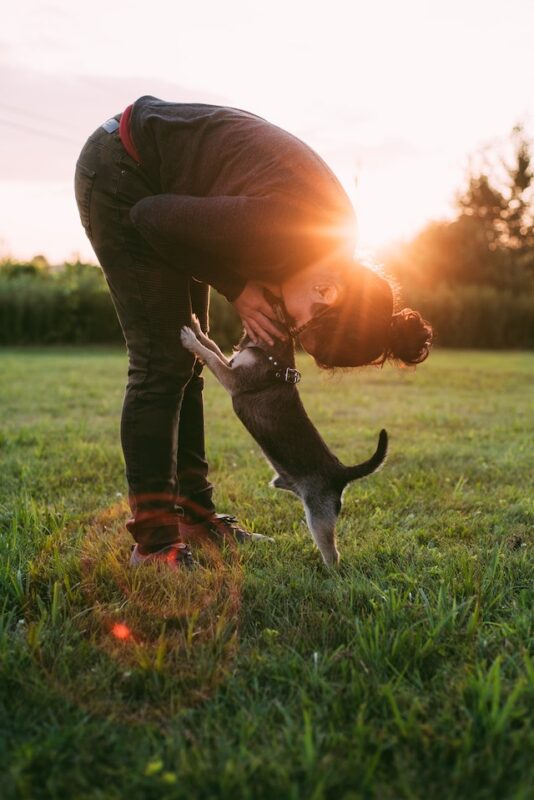How Do Dogs Show Affection?
Posted: 10/13/2022 | BY: Jenna Bruce | Categories: Behavior , Dog , Top Tips
If you share your life with a dog, you no doubt go out of your way to show them you love them. You let them hog the bed, walk them even when you’re sick, and give them that last perfect bite of sandwich. But have you ever wondered how dogs show affection?

There are some displays of affection that seem pretty obvious. When your dog hops onto the sofa and leans into you, you can pretty much tell they love you. But you may be surprised by some of the other ways dogs show affection.
From subtle body language to profoundly silly displays of ga-ga, here are some of the surprising ways dogs show affection:
Tail Wagging
OK, let’s start with an obvious one. Dogs express emotion through their tail. Whether they are feeling fear, anxiety, joy or aggression, their tail is a telltale sign (say that ten times fast!). When a dog is happy, they will wag their tail so fast and furiously, their entire backside seems to shimmy back and forth. When you come home and your pup greets you at the door, tail waggin’, it’s puppy love.
They Lick Your face
While it can be a bit slimy and smelly, your dog’s licks are a sign of affection. Puppies will lick their mother’s faces when they are hungry and want to eat. So some “experts” might say your dog is just trying to tell you, “I want a snack hooman.”
But we also know that dogs groom each other as a gesture of intimacy and companionship. So your dog’s licks can definitely be taken as a sign of affection.
They Instigate Roughhousing
When you watch dogs play together, they roughhouse with one another. This is not only healthy behavior, it’s necessary for their social development. When your dog instigates roughhousing with you, it’s a way for them to bond even more with you and definitely a show of affection. So go for it! Just be sure to gently teach your dog what behaviors are and are not acceptable (i.e. biting and barking) so things don’t get out of hand.
They Want to Sleep with You
In the wild, wolves sleep together curled up against one another. When more than one dog shares a home, they will often curl up with one another. If your dog is an only dog and you are their human, they will want to sleep near you – and as close as you will let them. Now, there is much debate about whether or not you should or shouldn’t allow your dog to sleep in your bed, but the fact that they want to sleep as close to you as possible is a clear indicator of their affection.

They Watch Over You When You’re Sick
In the wild, wolves care for sick members of the pack and lick their wounds. Dogs possess this same instinct, which is why when you’re sick, you may notice your dog paying extra attention to you.
They Actually Smile at You!
Research has shown that dogs use many of the same facial expressions as humans do and will react “facially” to different people in different ways. So when you could swear your dog is smiling, they probably are because they are so happy to be with you. In fact, there is no place they’d rather be!

They Know Your name
You know that your dog learns their own name, but did you know they also learn yours as well? And that when they hear your name, they will get super excited because they think you are going to appear any minute? Yep, it’s ‘cause they love you.
They Try to “Herd” You
Some breeds, such as border collies and Australian shepherds, have been bred to herd livestock. But when these breeds become house pets, they often herd their humans to keep them safe. This is especially true with small children. You may have even seen some of these viral videos when the dog is herding the child to keep them from falling down stairs or walking into the road. Dogs love their family members very much and want to keep them safe.
They Share Their Toys with You
Have you ever come home from a long day at work, plopped down on your sofa, and your dog ran in with a toy and dropped it in your lap? Then they ran off, ran back in and dropped another toy in your lap. And another. And another. Dogs sharing their favorite toys with you is a definite sign of love and affection.
By the same token, your dog may sometimes offer you gifts you don’t love. Like a dead chipmunk or half-eaten bird. Don’t scold them for this, they want to please you and provide for you. Just thank them and dispose of the dearly departed as respectfully as you can.

They Sigh
Humans aren’t the only ones to let out deep sighs when they feel happy and content. Your pup will often do it, too, when in your presence. Be mindful of those soft vocalizations your dog may perform, such as sighs and slight groans. They are a sign he or she is in Heaven by your side.
Pay special attention to these signs that your dog loves you because it can strengthen the bond between you both even more. We wish you and your fur baby many affectionate years together!
Show Your Pup You Love Them by Enrolling Them in a Pet Insurance Plan
We want to do everything we can to keep our best friend happy and healthy. And that’s why it’s so important to enroll them in a comprehensive pet insurance plan.
The cost of veterinary care is skyrocketing. Will you be able to afford care should your fur baby experience an unexpected illness or injury? Some insurance plans can reimburse you for up to 90% of the vet bill!
Show your pup you love them right back. Get a free insurance quote today.
References:
- 7 Surprising Ways that Dogs Show Affection. Retrieved from: https://www.rover.com/blog/how-dogs-show-affection/
- How Do Dogs Show Affection? 11 Ways Dogs Show Affection. Retrieved from: https://www.masterclass.com/articles/how-do-dogs-show-affection
- How Do Dogs Show Affection to Humans? Retrieved from: https://www.dogster.com/dog-training/how-do-dogs-show-affection
The information contained on this blog is intended for informational and educational purposes only and should not be construed as medical advice. It is not a substitute for professional veterinary care. Always consult with your veterinarian before making any changes to your pet's health care or treatment plan.
The authors of this blog are not veterinarians and do not claim to be experts in pet health. The information provided here is based on our own experiences and research, as well as information from reputable sources. However, we cannot guarantee the accuracy or completeness of this information.
We encourage you to do your own research and consult with your veterinarian before making any decisions about your pet's health.
Previous post
Can Pets See Ghosts?Compare top pet insurance providers plans.
Enter your dog’s age in years and months to calculate their age equivalent to human years.
Calculate your dog’s ageEnter your cat’s age in years and months to calculate their age equivalent to human years.
Calculate your cat’s age